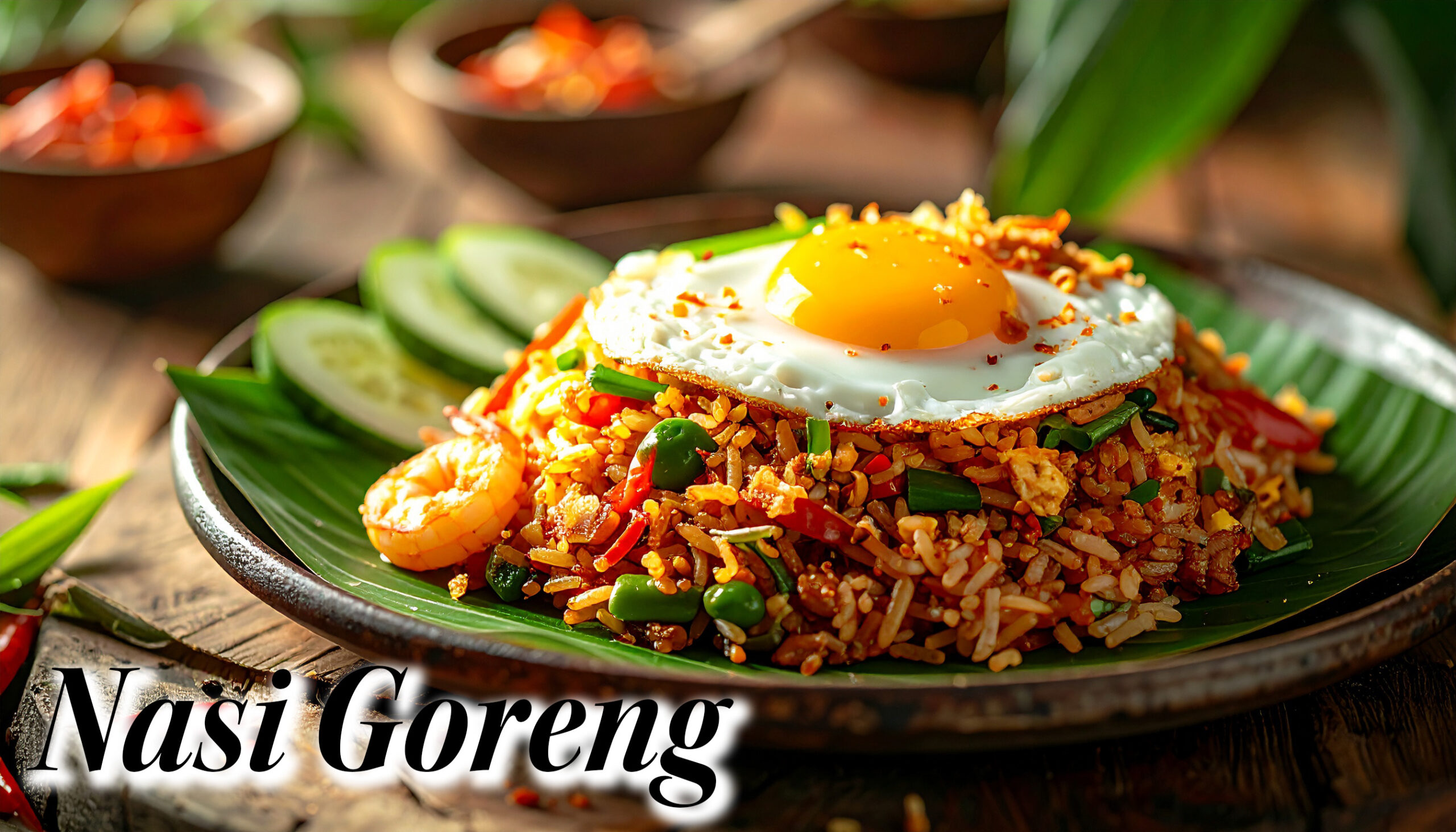Do you know about Nasi Goreng?
This dish, with its very colorful appearance, is popular mainly in Indonesia.
It is commonly eaten daily, and its relative ease of preparation is another appealing aspect.
So this time, I'd like to give you a thorough introduction to Nasi Goreng—from its history all the way to how it's made!
Please enjoy it all the way to the end.
What is Nasi Goreng?

Nasi Goreng is a representative home-style dish of Indonesia.
It is primarily popular in Indonesia, but it is also widely known in neighboring countries such as Malaysia, Singapore, and Thailand.
“Nasi” means “rice” in Indonesian, and ‘Goreng’ means “to fry.”
Therefore, nasi goreng literally means “fried rice.”
It certainly looks like fried rice, doesn't it?
However, it differs from the Japanese version in that it is sweet, savory, and spicy.
The use of spices and chili paste is what distinguishes it from Japan's simple fried rice.
Additionally, the aroma imparted by garlic and shallots (onions) is exceptional, further enhancing the flavor of nasi goreng.
And the krupuk nestled within the moist rice creates a crisp texture accent with every chew.
The overall flavor stimulates the appetite, offering the distinctive impact that makes ethnic cuisine so appealing.
The History of Nasi Goreng

Nasi goreng is a type of fried rice, but it is also a dish layered with cultural and historical significance beyond being simply fried rice.
When you think of fried rice, you think of China, right?
The cooking method of stir-frying the rice for this nasi goreng is also believed to have been introduced from China through trade and immigration.
For example, Indonesian sources cite a description stating that “people who came from southern China in the 10th century used stir-frying techniques.”
This fried rice, originating from China, later incorporated local flavors and ingredients unique to the region.
The distinctive flavor of nasi goreng is shaped by ingredients such as sweet soy sauce (kecap manis), chili paste, shallots, and shrimp paste.
Thus, while retaining the structure of “stir-fried rice,” it became a distinct entity from Chinese fried rice through its unique flavor, aroma, and combination of ingredients.
Additionally, in every region, it strongly emphasizes the aspect of “utilizing leftover rice in dishes to avoid waste.”
“Leftovers = stir-fry for the next day's breakfast” became a staple practice in the food culture of ordinary people.
It is believed that Nasi Goreng spread beyond Indonesia through trade and immigration during the 19th and 20th centuries.
This historical background has elevated nasi goreng to the status of a “national dish” and made it a well-known cuisine even outside Indonesia.
In modern times, nasi goreng is regarded as one of Indonesia's “representative dishes.”
Research and reports indicate that diverse variations exist across regions, with dozens to over 100 types of nasi goreng.
Fun Facts and Interesting Stories About Nasi Goreng
Popular for breakfast too! “Leftovers Revival Recipes”
Nasi goreng was born as a dish that repurposes leftover rice from the previous day.
Cooked rice left out will spoil quickly in the tropics.
Therefore, it evolved from the wisdom of enhancing preservation by stir-frying and adding spices.
It is also characteristic that it is often eaten for breakfast in Indonesia.
The taste varies completely by region!

Indonesia is a multi-ethnic nation comprising over 10,000 islands.
Therefore, there are various regional variations of nasi goreng.
- Javanese-style Fried Rice (Nasi Goreng Jawa): Sweet and savory, with a generous amount of kecap manis
- Balinese-style (Nasi Goreng Bali): Uses a lot of sambal and_ is quite spicy
- Sumatran-style (Nasi Goreng Sumatra): Strong flavor of shrimp paste
Even the same “nasi goreng” can sometimes taste like a completely different dish.
Nasi Goreng's “friend” is Krupuk

Krupuk, which is almost always served alongside nasi goreng, is a type of fried cracker made from tapioca flour and shrimp.
Light and fluffy in texture, it contrasts nicely with the moist rice of nasi goreng.
In Indonesia, nasi goreng and krupuk are such a staple combo that they're practically a set.
Now a national dish in the Netherlands too!
As a remnant of the colonial era, nasi goreng is also very popular in the Netherlands.
In the Netherlands, it is an essential dish in the Indonesian-style course meal known as “rijsttafel” (rice table).
Even in Dutch supermarkets, you can find “Nasi Goreng sauce” and “spice mixes” for sale.
Nasi Goreng and Pop Culture
There is also a song called “Nasi Goreng” sung by an Indonesian singer.
Furthermore, Nasi Goreng is a dish so deeply rooted in people's lives and humor that it even appears on Indonesian TV shows and comedy programs.
How to Make Nasi Goreng
Ingredients (for 2 people)
- Rice (cold rice is best) ... approximately 400g
- Chicken thigh meat or shrimp...100g
- Onion... 1/4 (finely chopped)
- Garlic... 1 clove (minced)
- Bell pepper or paprika... 1/2 (thinly sliced)
- Eggs... 2
- Salad oil... 2 tablespoons
- Fish sauce (or nam pla) ... 1 tablespoon
- Kecap Manis (sweet soy sauce) ... 1 tablespoon
※If unavailable, substitute with “soy sauce + 1 teaspoon sugar”. - Chili sauce or sambal (spicy condiment) ... 1 to 2 teaspoons
- Salt... a pinch
- Pepper... a little
- For topping: Fried egg... 1
- Optional accompaniments: cucumber, tomato, prawn crackers (krupuk)
How to make them
- Preparation
- Cut the chicken and shrimp into bite-sized pieces and lightly sprinkle with salt and pepper.
- Fluff the rice. If using cold rice, lightly warm it in the microwave to make it easier to stir-fry.
- Stir-fry the ingredients
- Heat oil in a frying pan and sauté the garlic and onion.
- Once the aroma rises, add the meat and shrimp and stir-fry until cooked through.
- Add the bell peppers and stir-fry briefly.
- Add rice
- Add the rice and stir-fry while thoroughly mixing in the ingredients.
- Season
- Add kecap manis, fish sauce, and chili sauce, then mix well to incorporate the flavors throughout.
- Taste and adjust with salt and pepper.
- Finishing
- Make fried eggs in another frying pan.
- Scoop rice onto a plate and top it with a fried egg.
- Serve with sliced tomatoes, cucumbers, and shrimp crackers as desired.
Flavor and Characteristics
- Sweet and savory, with a hint of smokiness.
- The sweet-salty flavor of ketchup manis and the savory umami of fish sauce are perfectly balanced.
- When you break the yolk of a fried egg and mix it in, it creates a mellow and rich flavor.
Summary
How was it?
This time, we introduced Nasi Goreng, Indonesia's beloved national dish.
I hope I've conveyed why it's still beloved today, imbued with diverse food cultures and history!
I really love spicy food, so I think I'll try making it at home next time.
Now, regarding the availability of nasi goreng in Japan, it seems to be a relatively common dish.
However, they are not found everywhere in the country and tend to be more common in urban areas and tourist destinations.
For example, it appears as a staple menu item at Indonesian restaurants and Southeast Asian restaurants.
Making it at home is fun, but if you're looking for the real deal, heading to a specialty shop like this is totally worth it!
Discover your favorite way to enjoy it from the many options available!
Thank you for watching until the very end!
Feel free to check out our other articles too!




Comment